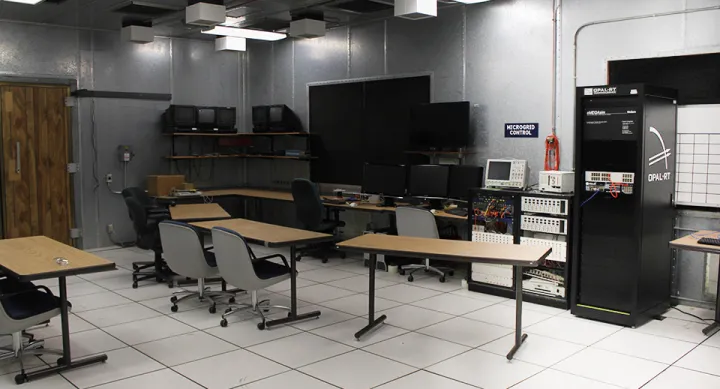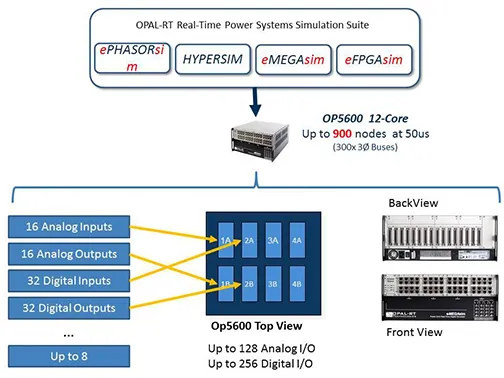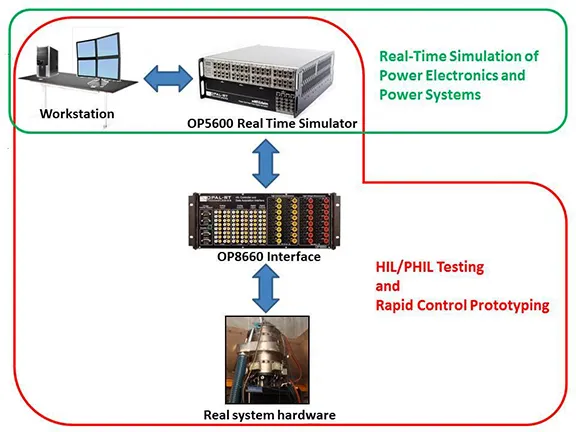
Experience with microgrid technology demonstration programs revealed the need for an integrated high speed hardware/software data acquisition and processing system with mixed signal capability and multi-input/output flexibility to achieve in particular the following goals:
• To accelerate computer simulations
• To facilitate HIL testing and its related controller HIL (CHIL) and power HIL (PHIL) testing
• To enable rapid prototyping of control systems (RCP)
Modern terrestrial grid and military operations are becoming ever more dependent on the availability of high quality reliable electrical power. Power system synthesis and evaluation studies rely heavily on computationally intensive computer simulations that must be supported with appropriate validation experiments. In support of these goals, an Opal-RT Multi-purpose Real Time Simulator (MRTS) system was procured under an Army DURIP Grant, and is currently being integrated into CEM’s power system testbed.

Figure 1: Opal-RT MRTS
The MRTS will enable detailed simulation of more complex power systems (or simulation of more cases) as well as hardware-in-the-loop (HIL) testing and the development of control systems to manage these tasks in real applications.
A schematic diagram illustrating the planned use of the MRTS system is shown in Figure 2. When used to accelerate computer simulations (green frame), the MRTS will accept existing (and future) MATLAB/Simulink models to perform resource-intensive calculations. This will result in accelerated runs, and likely, it will be the most common use as the MRTS will be shared among users on the same network:

Figure 2: Schematic diagram of the Multi-purpose Real Time Simulator applied at UT-CEM
When used for HIL (red frame), the MRTS will run models (plants) in real time to aid in controller design and testing. When used as a PHIL (red frame), the plant running on the MRTS will drive real hardware in a lab. The hardware response will be fed back to the MRTS to obtain a completed-interfaced plant (e.g., power system model) interfaced to local power apparatus (e.g. energy storage systems). When used for RCP (red frame), the MRTS will accept controller models designed in Simulink and act as the real- time controller for the actual power system testbed. In fact, several controllers will be deployed onto the same MRTS to mimic decentralized control architectures in real time that will autonomously control the equipment in the power system testbed.
It should be noted that the proposed MRTS system accepts models created in MATLAB/Simulink, SimPowerSystems, and SimScape. This is an important realization, allowing programs already developed in these packages to run in the real time simulator immediately with no modifications
Finally, the MRTS system provides a foundation for an expanded real time computational facility, as the system can easily be scaled up by adding additional processors and interface units in the future. The initial processor’s capabilities are summarized in Figure 3.

Figure 3: Capabilities of the processor planned for the initial MRTS
In addition to supporting naval power system research, the MRTS will be used to support research into the design of grid controllers for integration of renewables and energy storage to the terrestrial microgrid, and existing Army funded activities exploring optimal electric distribution and machine design for tactical microgrids. The MRTS will be a key piece of processing and test equipment for the power system testbed and will enable research into critical power architecture issues both from the theoretical simulation perspective and from the standpoint of experimental hardware testing and synthesis/de-risking of control strategies.
Contact

Dr. Robert Hebner
r.hebner@cem.utexas.edu
512-232-1628
Projects

Electric Ship
The Center for Electromechanics has a major research program to improve electric ship technology.

Microgrid EM Launch Integration
Emerging high-power electric weapons and sensors are creating significant challenges for naval power systems.

HIL Testing
Experience with microgrid technology demonstration programs revealed the need for an integrated high speed hardware.


